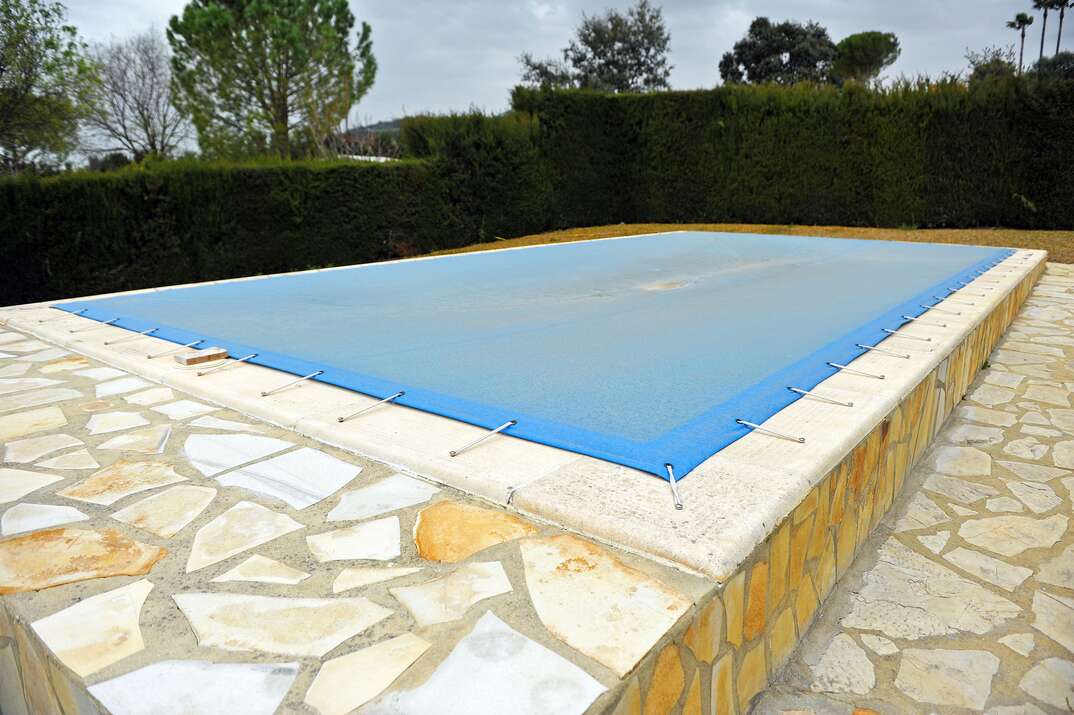Here's How to Close Your Swimming Pool For the Season

Winterizing Your Pool at a Glance
- Step 1: Clean and test water
- Step 2: Add winterizing chemicals
- Step 3: Filter water
- Step 4: Shock it
- Step 5: Install skimmer plate
- Step 6: Plug return fitting
- Step 7: Remove lights
- Step 8: Add winter-grade chlorine
- Step 9: Insert air pillows and cover
- Step 10: Add safety cover and water
- Step 11: Clean filter
Every pool season comes to an end — particularly if you live in a part of the U.S. that experiences cold winters. As a pool owner performing your own pool maintenance, it's ideal that you know how to winterize your pool so you can close it for the winter. The truth is that what you do for your pool now will determine how much trouble your pool is to open when summer comes back around.
This May Also Interest You: Putting in a Pool? Here’s Everything You Need to Know
Here’s a primer on how to winterize your pool and close it down for the winter.
 ----------------------------------------
----------------------------------------
Can I Close My Pool Myself?
Yes. Although there’s a bit of elbow grease required to do so, most folks find that taking a few hours to close their pools themselves can save them the cost of hiring a pool professional to do the job.
How Do You Close an Above-Ground Pool for the Winter?
When summer grinds to a halt, it’s time to close the pool — unless you have a pool heater and intend to use your pool beyond the typical season. Closing your above-ground pool should be a straightforward and hassle-free process. The Pool Factory says you should follow these steps to ensure your pool water is in the best shape possible to reopen when warmer weather rolls around:
Step 1: Clean and Test Water
If you have an automatic pool vacuum, allow it to run for the amount of time specified by the manufacturer to ensure that all debris, dirt, leaves and other items are removed from your pool’s water.
Use a test kit to check your pool’s alkalinity and pH levels. Add the appropriate amount of chemicals to your pool and bring its alkalinity and pH levels within their acceptable ranges.
Step 2: Add Winterizing Chemicals
You can buy a winterizing pool kit or a pool closing kit that contains everything you need to close your pool for the winter, including chemicals that prevent the growth of algae during the winter. This can be beneficial in keeping your pool clean in the off-season.
Step 3: Filter
Run the filter system on your pool for a minimum of one hour. If your pool is particularly dirty, be sure to backwash your filter system halfway through.
Step 4: Shock It
Shock the pool for a final time before closing it, using winterizing shock. Add your chosen shock chemicals and apply the shock to your pool according to the manufacturer's instructions. Allow your pump to run overnight after shocking the pool. Then, test your water again the next day to make sure it’s balanced. Correct any problems before proceeding to the next step.
Step 5: Install Winterizing Skimmer Plate
Insert a winterizing skimmer plate into your pool’s through-the-wall skimmer. This will generally involve removing the screws that hold the plate that attaches your pool skimmer to the pool wall. Keep in mind that you do not need to lower the water level of your pool below the skimmer when you are putting on this winterizing plate. This is especially true in areas where winters are harsh. Keeping the water level at or slightly lower than the skimmer is fine.
Step 6: Plug Return Fitting
Using a threaded winterizing plug, plug the return fitting on the inside of your pool. Push the plug all the way in, making sure that it is flush with the pool wall.
Step 7: Remove Lights
Remove all the lights from your pool. This is an important step to ensure the lights don't get damaged over the winter.
Step 8: Add Chlorine
Before you cover the pool, add a pool floater with a winter-grade chlorine tab.
Step 9: Insert Air Pillows and Cover
Inflate your winterizing air pillow according to the manufacturer's instructions. Then, fasten it as directed, and allow it to float to the center of your swimming pool. Use more than one air pillow if you have a large pool. Position your winter cover over the air pillows so that it lays on the surface of your pool water. Your cover shields your water from sun damage, allowing your chlorine to continue working during the winter months. If the cover doesn’t fit tightly, you may need to remove your pool ladder.

Step 10: Add Safety Cover and Water
Add a safety cover. This helps ensure that no one falls in during the off-season. Using a garden hose, add up to 2 inches of water on top of the pool cover. This prevents damage from the wind.
Step 11: Clean Pool Filter
Lastly, empty your pool filter and clean it. Remove the drain plugs from your tank and the pump. Give the filter system time to drain completely, then dry it and store it inside or in your garage.
More Related Articles:
- Keep Your Pool Running Swimmingly With These Maintenance Tips
- How, When and Why to Drain Your Swimming Pool
- Not Ready to Go All-in? Here’s How Much a Semi-in-Ground Swimming Pool Costs
- How Much Does a Pool Heater Cost?
- How to Clean a Pool Filter
How Do I Close an Inground Pool?
The steps for closing an inground pool for the winter are the same as the steps required to close an above-ground pool. However, you may need to add antifreeze to your plumbing lines if you have an in-ground pool and live in a cold climate where freezing temps are possible.
Will Underground Pool Pipes Freeze?
Whether your underground pool pipes freeze depends on the care that you take in closing your pool. If you live in a warm climate, you may choose to blow out your lines. If you blow the lines of your pool properly, you should not have to think about the lines freezing at all. However, it is very difficult to get all the water out of your pool lines. If you have any doubt whatsoever about whether or not you are able to get the water out of these lines, it's necessary for you to add antifreeze to the lines. If you live in a colder climate, it’s probably best to add antifreeze to the lines.
What Chemicals Do I Need to Close My Pool?
Before closing it for the winter, you want to add chemicals to your pool to bring the pH, total alkalinity, calcium hardness and free chlorine within range, says Swim University. Some of the chemicals needed to make that happen (depending on the type of pool you own) include:
- Chlorine
- Copper algaecide
- Stain preventers for metallic tap water
- Pool enzymes
- Winter algaecide
- Non-chlorine pool shock
- Soda ash
- Muriatic acid
- Baking soda
You can also purchase a pool closing or pool winterizing kit that contains a curated mix of the chemicals you need.
Should I Drain My Pool for Winter?
Draining your pool every winter is not recommended other than for specific circumstances. Draining your pool creates the unnecessary expense of refilling your pool later on and may cause your pool liner to shrink, crack or rip when it dries out.
The bottom line is that closing your pool for winter the right way leads to easier opening of your pool when warm weather returns. A properly closed pool has water that is clean and safe, even when no one is swimming. With the right steps, your pool can be crystal clear and ready for minimal treatment when you peel its cover off next summer.


